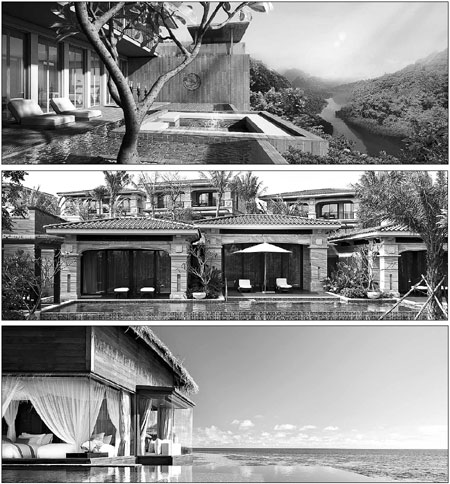Gimme shelter
Updated: 2013-03-17 08:39
By Rebecca Lo(China Daily)
|
|||||||

|
Top: The hot spring resort in Benxi, Liaoning province, is Clint Nagata's latest construction project. Nagata says his company's edge is its novel approach to each project and creating a property that reflects the client and location. Among his projects are Conrad Sanya (middle) and Jumeirah Maldives (above). Photos Provided to China Daily |
Bangkok-based Hawaiian native Clint Nagata of Blink Design finds China an exciting canvas for his brand of hospitality design. Rebecca Lo talks to the architect and discovers what feasts for the senses to expect.
Hawaii has long been the US' vacation state. For architects and designers who specialized in creating fantasy getaways, there was no better place to hone their craft during the '70s and '80s when luxury hotel development on the islands was at its peak.
It was the environment that Clint Nagata was born and bred in. The founder and creative director of Bangkok-based Blink Design Group grew up in Hawaii's North Shore.
He studied architecture at The University of Hawaii and worked for 14 years at one of the state's largest firms, WATG, eventually becoming one of its youngest partners.
"I've always had a passion for art and design," says Nagata. "But I unintentionally discovered this side of the design world - designing hotels and resorts. At school, firms that specialized in these building types were often frowned upon, yet (the late Sri Lankan architect) Geoffrey Bawa has long been one of my main design influences and inspirations."
Bawa, initially known for institutional buildings across his home country, became associated with a tropical modern aesthetic that was perhaps best executed in hotel designs such as Heritance Kandalama in Dambulla.
When Nagata felt ready to spread his own wings, he knew that Asia offered the best opportunities.
"I spent half my time working with clients in Asia and I became inspired by the caliber of design firms here," he says. "I chose Bangkok as the perfect city to set up my own firm, because I see it as an Asian design hub when it comes to resorts and hotels."
Nagata feels that Blink's edge over its competitors is its approach to each project: He aims to create a property that reflects his client and the location.
"We collaborate with our clients across different disciplines, having a strong understanding from both ends of the table," he says. "Whether we are hired as interior designers or architects, we are often sought out to lead the design team to provide a clear concept and vision for the project."
Nagata stresses that good design is instrumental to the success of a hotel, and it is a point that most of his clients understand, too.
"While one cannot ignore functionality and operational efficiency, there is too much competition today for a poorly designed hotel to succeed," he says. "Guests are highly driven to stay in places that are enticing and aesthetically pleasing."
Since Nagata founded Blink in 2006, the firm has worked on large-scale master planning right down to product and industrial design - and even brand identity and motion pictures.
Its impressive client roster includes big-name hoteliers such as Jumeirah, Dusit and Hyatt, as well as helping to cement brands such as Bluebird for Mercedes-Benz.
The firm currently has offices in Bangkok, its creative hub; Singapore, its business hub; New Delhi, its production hub; and a studio in Shanghai to fit its swelling Chinese client base.
Nagata has witnessed the exponential changes in China reflected in his own industry, with the most recent being increasingly more idiosyncratic properties, a far cry from the bigger-is-better mentality of a decade ago.
"To design a 500-key hotel with three to four restaurants was very common," he recalls. "Hotel designs today have shifted to become smaller and more individual. We already can see the transformation in first-tier cities.
"Also the design in areas like Shanghai and Beijing has matured, so less flashy, less glitzy design is more widely acceptable. However, there will be a huge push to develop resorts in other areas of China besides Sanya. The Chinese market needs weekend destinations that are an hour's drive or so from urban areas."
Nagata believes that this is the right direction for the region, with more niche hotels catering to different market segments instead of trying to be everything to everyone.
"The world is becoming smaller and smaller by the day," he says. "As a result, the need for hotels to be more individual, intimate and tailored to what their guests desire has never been more important."
As Blink's creative director, along with Alan Barr, Nagata gets to work on both a hotel's exterior and interior, a privilege the architect relishes.
"As an architect, it is inspiring to first set foot onto a beautiful site and to be able to visualize what the resort or hotel could look like," he says. "But I find it equally inspiring to filter out the white noise and come up with left-field ideas on materials, textures and other techniques."
Despite the many projects on Blink's drawing board and the jetsetting that comes with frequent site visits, Nagata has not lost his love for adventure.
"Traveling is my great passion, which is just as well because this job keeps me constantly on the road and living out of a suitcase," he states with a grin.
Contact the writer at sundayed@chinadaily.com.cn.
(China Daily 03/17/2013 page13)
